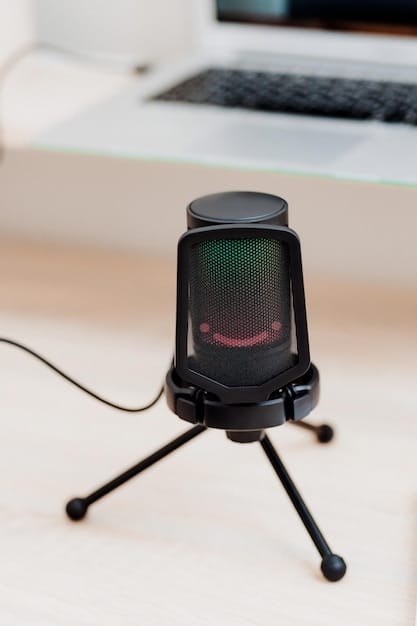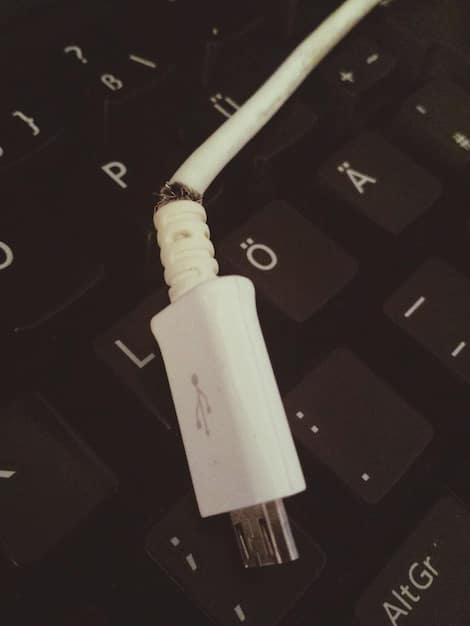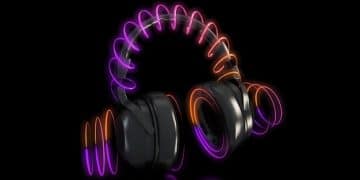USB Microphones: 5 Features for Clearer Voice Chat in 2025

USB Microphones: 5 Features to Consider for Clearer Voice Chat explores the most important aspects to look for when choosing a USB microphone to improve voice clarity for podcasting, gaming or remote work.
Are you tired of muffled audio during important voice chats? The solution might be simpler than you think: a quality USB microphone. When selecting the right one, it’s essential to consider certain key features that directly impact voice clarity. This article breaks down the USB Microphones: 5 Features to Consider for Clearer Voice Chat so you can make informed decision.
This comprehensive guide will explore five essential features to look for in USB microphones to ensure crystal-clear voice communication. By understanding these features, you can significantly enhance your audio quality in various applications, whether you’re gaming, podcasting, or simply participating in voice calls.
Understanding USB Microphones: 5 Features to Consider for Clearer Voice Chat
Selecting the right USB microphone can seem daunting due to the myriad of options. However, focusing on five critical features will help you narrow down your choices and find a microphone that delivers exceptional voice clarity. Understanding the different polar patterns, frequency response, bit depth and sample rate, connectivity, and build quality will ensure you invest in a microphone that meets your specific needs.
Polar Patterns: Capturing the Right Sound
The polar pattern of a microphone determines its sensitivity to sound from different directions. USB microphones typically offer cardioid, omnidirectional, or bidirectional patterns. A cardioid pattern picks up sound primarily from the front, rejecting noise from the sides and rear, making it ideal for solo voice recording. An omnidirectional pattern captures sound from all directions, suitable for group discussions. Bidirectional patterns pick up sound from the front and rear, ideal for interviews.
- Cardioid: Best for single-person recording, reducing background noise.
- Omnidirectional: Captures sound from all directions, suitable for group environments.
- Bidirectional: Records sound from the front and rear, perfect for interviews.
Choosing the right polar pattern ensures that only your voice is captured, minimizing unwanted background noise. This is essential for achieving clearer voice chat, whether you’re streaming, recording a podcast, or participating in online meetings. This is one of the key USB Microphones: 5 Features to Consider for Clearer Voice Chat.

Frequency Response: Capturing Full Range Audio
Frequency response refers to the range of frequencies a microphone can accurately capture. A wider frequency response ensures that the microphone picks up both low and high frequencies, resulting in a more natural and complete sound.
Look for microphones with a frequency response range that closely matches the human voice, typically between 20Hz and 20kHz. This range ensures that your voice is captured accurately, without any frequencies being cut off.
Bit Depth and Sample Rate: High-Resolution Audio
Bit depth and sample rate are critical for capturing high-resolution audio. Bit depth determines the dynamic range of the audio, while sample rate determines the number of samples taken per second. Higher bit depth and sample rates result in more detailed and accurate audio recordings.
- Bit Depth: 16-bit is good for basic voice recording, while 24-bit offers higher quality.
- Sample Rate: 44.1kHz is sufficient for most applications, but 48kHz or higher provides better quality.
For professional-quality voice chat, consider microphones that support 24-bit bit depth and sample rates of 48kHz or higher. These specifications ensure that your voice is captured with exceptional clarity and detail.
The features mentioned are critical factors to consider when evaluating USB Microphones: 5 Features to Consider for Clearer Voice Chat to enhance overall audio quality.
Connectivity and Compatibility of USB Microphones
The connectivity and compatibility of a USB microphone are essential for easy setup and seamless integration with your devices. USB microphones are designed to be plug-and-play, making them incredibly easy to set up with computers and other devices.
USB Connection Types
USB microphones typically use either USB-A or USB-C connections. USB-A is the standard rectangular USB connector, while USB-C is a smaller, reversible connector that offers faster data transfer speeds.
- USB-A: Standard USB connector, widely compatible with most devices.
- USB-C: Offers faster data transfer speeds and is becoming increasingly common.
Ensure that the USB microphone you choose is compatible with your device’s USB port. If your device only has USB-C ports, you may need to use a USB-A to USB-C adapter if your microphone has a USB-A connector.

Driver Compatibility
Most USB microphones are class-compliant, meaning they don’t require any additional drivers to be installed. Simply plug the microphone into your device, and it should be automatically recognized. However, some microphones may require specific drivers to be installed, especially if they offer advanced features or customization options.
Check the manufacturer’s website for driver downloads and compatibility information before purchasing a USB microphone. Ensuring driver compatibility will save you time and hassle during setup.
The ease of connectivity and broad compatibility make USB microphones a popular choice for users seeking hassle-free audio solutions. This plug-and-play functionality is a key advantage that enhances the user experience, particularly when considering USB Microphones: 5 Features to Consider for Clearer Voice Chat.
Build Quality and Durability of USB Microphones
The build quality and durability of a USB microphone are important factors to consider, especially if you plan to use the microphone frequently or in different environments. A well-built microphone will withstand daily use and provide reliable performance over time.
Materials and Construction
Look for USB microphones that are constructed from high-quality materials, such as metal or durable plastic. Metal construction typically offers better durability and a more premium feel, while high-quality plastic can be lightweight and resistant to impacts.
Shock Mounts and Pop Filters
Shock mounts and pop filters are essential accessories that can enhance the build quality and performance of a USB microphone. A shock mount isolates the microphone from vibrations, reducing unwanted noise caused by desk bumps or handling. A pop filter reduces plosive sounds, such as “p” and “b” sounds, resulting in cleaner and clearer vocal recordings.
- Shock Mount: Isolates the microphone from vibrations, reducing noise.
- Pop Filter: Reduces plosive sounds for cleaner recordings.
Investing in a USB microphone with robust build quality and essential accessories will ensure that your microphone lasts longer and delivers consistent performance. These are critical features to consider when evaluating USB Microphones: 5 Features to Consider for Clearer Voice Chat to enhance overall audio quality.
Additional Features to Enhance Voice Chat Clarity
Beyond the essential features, several additional features can further enhance the clarity of your voice chat. These features may not be critical, but they can significantly improve your overall audio experience.
Built-in Headphone Jack
A built-in headphone jack allows you to monitor your audio in real-time, without any latency. This is particularly useful for ensuring that your voice sounds clear and that you are not experiencing any audio issues.
Look for USB microphones with a headphone jack that offers volume control, allowing you to adjust the monitoring volume to your preference.
Gain Control
Gain control allows you to adjust the input level of the microphone, ensuring that your voice is neither too quiet nor too loud. Proper gain control prevents clipping and distortion, resulting in clearer and more professional-sounding audio.
- Adjust Input Level: Prevents clipping and distortion.
- Ensure Clear Audio: Optimizes voice volume for better communication.
Having gain control on your USB microphone gives you greater control over your audio, allowing you to fine-tune your settings for the best possible sound.
Adjusting the gain control is essential for optimizing audio clarity and ensuring that your voice is neither too quiet nor too loud. This adjustment is crucial for maintaining a professional and clear sound during recordings, emphasizing the importance of USB Microphones: 5 Features to Consider for Clearer Voice Chat.
Optimizing Your Setup for Best Voice Chat Results
Even with the best USB microphone, optimizing your setup is crucial for achieving the best possible voice chat results. Proper microphone placement, acoustic treatment, and software settings can all contribute to clearer and more professional-sounding audio.
Microphone Placement
Position your USB microphone correctly to capture the best possible sound. Place the microphone close to your mouth, but not so close that it picks up excessive breath sounds. Experiment with different angles to find the sweet spot that captures your voice clearly and minimizes background noise.
Acoustic Treatment
Treat your recording environment to reduce echo and reverberation. Use acoustic panels, curtains, or other sound-absorbing materials to dampen sound reflections and create a more controlled environment. This results in cleaner and clearer audio recordings.
Software Settings
Adjust your software settings to optimize your audio for voice chat. Use noise reduction and echo cancellation features to minimize unwanted background noise and improve voice clarity. Experiment with different EQ settings to fine-tune your voice and make it sound its best.
Optimizing your setup involves strategic positioning, acoustic adjustments, and software configurations to enhance the clarity of your voice chat. This holistic approach ensures the best possible sound quality, emphasizing the practical application of understanding USB Microphones: 5 Features to Consider for Clearer Voice Chat.
| Key Feature | Brief Description |
|---|---|
| 🎤 Polar Pattern | Determines the mic’s sensitivity to sound directions. |
| 🎧 Frequency Response | Captures full range audio for natural sound. |
| ⚙️ Bit Depth & Rate | Ensures high-resolution audio recording quality. |
| 🛠️ Build Quality | Impacts microphone durability and performance consistency. |
Frequently Asked Questions
When selecting a USB microphone, consider polar patterns, frequency response, bit depth, sample rate, connectivity, and build quality, as these USB Microphones: 5 Features to Consider for Clearer Voice Chat significantly impact the clarity of your voice communication.
The polar pattern determines the microphone’s sensitivity to sound from different directions. Choosing the right pattern, such as cardioid for solo recording, can minimize unwanted background noise and improve voice clarity.
For professional-quality voice chat, it’s recommended to use a USB microphone that supports a bit depth of 24-bit and a sample rate of 48kHz or higher, as these specifications ensure that your voice is captured with exceptional clarity and detail.
Yes, USB microphones are generally designed to be plug-and-play, making them incredibly easy to set up with computers and other devices. Most are class-compliant and don’t require additional drivers.
To optimize your voice chat results, focus on proper microphone placement, acoustic treatment of your recording environment, and adjusting software settings like noise reduction and EQ to enhance voice clarity. Consider these USB Microphones: 5 Features to Consider for Clearer Voice Chat.
Conclusion
Selecting the right USB microphone involves careful consideration of several key features, including polar patterns, frequency response, bit depth, sample rate, connectivity, and build quality. By understanding these aspects, you can make an informed decision and choose a microphone that delivers exceptional voice clarity for your specific needs.
Optimizing your setup, including microphone placement and acoustic treatment, further enhances your voice chat experience. With the right microphone and setup, you can enjoy crystal-clear voice communication in various applications, elevating your gaming, podcasting, or remote work experience.





